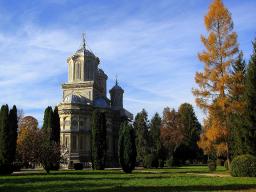

In the Middle Ages, Romanians lived in three distinct principalities: Wallachia (the territory between Danube River and the Carpathians), Moldavia (the territory in east and north eastern part) and Transylvania (central and north western part). By the 11th and 12th century, the nomadic confederacy of the Cumans and (Eastern) Kipchaks (who are considered to be either the eastern branch of the Cumans or a distinct but related tribe with whom the Cumans created a confederacy) were the dominant force over the vast territories stretching from the present-day Kazakhstan, southern Russia, Ukraine, to southern Moldavia and western Wallachia. By the 11th century, the area of today's Transylvania became a largely autonomous part of the Kingdom of Hungary. Kings of Hungary invited the Saxons to settle in Transylvania. Also living in Transylvania were the Szekely (szekely magyar). They were an ancient Magyar tribe which had arrived after the Avars (they had the same language). Transylvania was part of the Kingdom of Hungary from the 10th -11th century until the 16th century, when it became the independent Principality of Transylvania until 1711. Independent Wallachia has been on the border of the Ottoman Empire since the 14th century and slowly fell under the suzerainty of the Ottoman Empire during the 15th century. One famous ruler in this period was Vlad III the Impaler (also known as Vlad Draculea). Prince of Wallachia in 1448, 1456–62, and 1476. In the English - speaking world, Vlad is best known for the legends of the exceedingly cruel punishments he imposed during his reign and for serving as the primary inspiration for the vampire main character in Bram Stoker’s 1897 novel Dracula. As voivode, he maintained an independent policy in relation to the Ottoman Empire, and in Romania he is viewed by many as a prince with a deep sense of justice and a defender of both Wallachia and European Christianity against Ottoman expansionism.
Day 1 Bucharest – Pitesti – Curtea de Arges
Meet your guide (Airport, or at your hotel). Leave Bucharest for Curtea de Arges, the former second capital of Wallachia. Visit the strongholds of the former Princely Court rebuilt in the 14th century. See its Princely Church and its frescoes interior which is one of the first examples of Romanian religious painting. The Episcopal Church (the monastery) which is a recreation of the original built in 1512 -1517 by Prince Neagoe Basarab (rebuilt in 1875 – 1885). Than we’ll continue our route to Poienari Castle. Standing on a cliff but knows in ruins this is known as the real castle of Vlad the Impaler. To get to the top you must climb up its 1400 steps (takes approx. 1 hour). Once you arrive to the top of the Citadel you will find that the citadel is surprisingly small, one third has collapsed down the mountainside in 1888. Entering through a narrow wooden bridge, you come across the crumbling remains of two towers within; the prism shaped one was Vlad's (Dracula's) residential quarters, from here, according to the legend,The Impaler's wife flung herself out from the window, declaring that better this way than be captured by the Turks, who were besieging the castle. Legend has it that Vlad himself escaped over the mountains on horseback. Overnight to Curtea de Arges on a 3*/4* hotel.
Day 2 Curtea de Arges – Sibiu
After the breakfast we’ll continue our journey in the middle age once that we are about to get in the narrowpath of Olt River at Cozia Monastery. The Monastery was built between 1386 and 1388 in a region which, at that time, was difficult to reach, but where walnut trees easily grew; the name of the place itself derives from the Petcheneg-Cumanian term "coz" = walnut, which became Cozia = nut grove. The amazing scenery will keep us company till Sibiu (Hermannstadt) the cultural capital of the Siebenburgen and European Cultural Capital in 2007. Here we shall visit its beautiful center that reminds the old days: Large Square, the Evangelic Church, the Liar’s Bridge and many more. Dinner in a restaurant tasting Romanian cuisine. Accommodation in a 3*/4* hotel in Sibiu
Day 3 Sibiu – Carta – Fagaras – Codlea – Brasov
The journey continues right after the morning meal heading Fagaras Mountains – The Alps of Transylvania. Our first day stop will be at Carta where it stands ‘Transylvania’s most beautiful ruin’ – Kerz Church . In 1202 the Cistercians founded the order’s most easterly monastery in Europe here. The nave has collapsed, but the choir is still used today by the Protestant church for their church services. Following the Olt River upstream we reach Fagaras town – built in 15th century by princes that ruled Transylvania. Passing through Saxon villages we reach Codlea and stop for a visit. Codlea was mentioned as a burg as early as in 1265. A second Fortress, which has been preserved to the day, was built by the craftsmen of several guilds starting from 1432. It is interesting to note that the church has no steeple. From here we’ll stop at Bran Castle, known as Dracula Castle. In 1212 the Teutonic Knights built the wooden castle of Dietrichstein as a fortified position in the Burzeland at the entrance to a mountain valley through which traders had traveled for more than a millennium, although it was destroyed in 1242 by the Mongols. The first document mentioning of Bran Castle is the act issued by Louis I of Hungary on November 19, 1377, giving the Saxon of Kronstadt (Brasov) the privilege to build the stone citadel on their own expense and labor force. The castle was first used in 1378 in defense against the Ottoman Empire, and later became a customs post on the mountain pass between Transylvania and Wallachia. Visiting the main highlights of Brasov - the Council Square, the Black Church, Ecaterina’s Gate, the Rope’s Street, the Weaver’s bastion – will end a beautiful day. Accommodation on a 3*/4* star hotel or guesthouse in Brasov
Day 4 Brasov – Sinaia – Bucharest / Airport
Today heading south we’ll visit Peles Castle – the former summer residence of the royal family a Neo-Renaissance castle placed in an idyllic setting in the Carpathian Mountains. The tour ends at the airport / hotel in Bucharest.
684 euros/pers (accommodation on 4* basis)
590 euros/pers (accommodation on 3* basis)
* NOTE: Booking necessary at least 7 days (low season) 30 days (peak season) ahead
INCLUDED:
• Accommodation on as specified on 3*/4* basis
• Breakfast except the day of arrival
• Transportation by car or minivan
• Guide / driver English language, entrance tickets at visited sites
• Local taxes, parking fees and fuel
NOT INCLUDED:
• Air fare
• Personal insurance
• Photo extra fees at visited sites
• Other personal expenses
• Lunch and dinner
~ Gratuities
NOTE:
- The price is in euros per person based on DOUBLE occupancy
- SINGLE occupancy on request
- The tour can be customized on your request